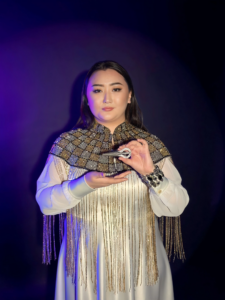The Astana Times provides news and information from Kazakhstan and around the world.ASTANA — Aizada Kemel, a Kazakh ethno-musician and composer, brings the natural rhythms of the steppe to life through unconventional instruments and vocal techniques that mimic the sounds of nature. In an interview with The Astana Times, Kemel shared how she forged a musical path from dombyra, an iconic two-stringed instrument, to an experimental sound rooted in nature.
Aizada Kemel, a Kazakh ethno-musician. Photo credit: Kemel’s personal archivesIn her performances, birds call across invisible skies, wolves howl from hidden hills, and hooves strike ancient ground. At first listen, the sound seems digital—layered or manipulated.

But it is just her: one musician, breathing through clay flutes, coaxing vibration from iron, imitating life through voice. Born in Kokshetau in northern Kazakhstan, Kemel has spent years transforming traditional instruments and techniques into something both ancestral and alive. She calls herself an ethno-musician, but what she does resists easy labels.
From sound to spiritKemel leans into vocal imitation and resonance. The result feels spiritual, but not in a rehearsed or scripted way. “It is a mix of different compositions that already exist and improvisation,” she said.
One of her pieces, “Uly Dalanyn Kone Saryndary” (Ancient Echoes of the Great Steppe), blends her own animal imitations with excerpts from local composers Akhmedyar Yesmukhanov’s “Nurly Beine” and Ruslan Koishybayev’s “Karakhan Baba.”The piece opens with the sazsyrnai, a traditional clay wind instrument, where she imagines dawn breaking over the steppe, followed by a vocal imitation of an eagle soaring in the sky and birds waking to a new day. That transitions into a lyrical section borrowed from “Nurly Beine,” which she interprets as a love story—two people meeting on the vast open land, falling for each other under wide skies.
Then comes the shankobyz, a metal jaw harp that produces sound when held between the teeth and plucked, where the mood shifts.“There, vocally, I bring in the sound of birds again, then the howl of a wolf—because we value the wolf as a sacred ancestor,” she said. copy_1400BC74-6734-4406-9463-05CF773B88B6The final section, fast-paced and percussive, is drawn from “Karakhan Baba,” played on dombyra along with her part on shankobyz.
“That is the gallop of horses. I imagined our warriors riding out—strong, determined, heading into the unknown,” said Kemel.Though her sound is comparable to throat singing, Kemel highlighted that techniques and sounds are very different.
“Throat singing has its own schools and styles—kargyra, sygyt, khoomei,” she said. These are deeply rooted in Tuvan and Mongolic traditions, and though some Kazakh musicians study them, they are not widely practiced among women.“Throat singing can be dangerous for the voice, especially for women.
It affects the vocal cords, the thyroid—so I have not gone too deep into it yet,” said Kemel.From strings to windKemel’s formal music education began with the dombyra. She studied it for a decade—first at a local music school, then at the music college named after Birzhan Sal in Kokshetau.
However, when she applied to the Kurmangazy Kazakh National Conservatory in Almaty, she hit a wall of sameness.“There were dozens and dozens of dombyra applicants. I was almost the 80th on the list.
The woman at admissions looked at me and said, ‘Why not try something else?’” said Kemel.That suggestion altered her path. Though she had played the sazsyrnai in competitions, she had never considered it a career.
“But she [a woman at the admissions] told me, ‘even if you study sazsyrnai, no one is taking the dombyra away from you. You will still have it. But this will open new doors.
’ So I agreed and got accepted,” said Kemel.She soon discovered a sybyzgy, a reed flute made from cane, and a shankobyz. The vibrations travel through the skull and body, creating a resonance felt as much as heard.
“They sparked my interest. I started researching, learning them on my own, watching videos, experimenting, and just listening,” Kemel added.Motherhood, curiosity and the pandemic sparkHer experimentation deepened during COVID-19 when, pregnant and then caring for her newborn son, she found herself with time and curiosity.
At home in Almaty, she discovered performances by Olena UUTAi, a Yakut musician who brought the khomus, which is the Sakha name for jaw harp, to international stages such as Britain’s Got Talent.Kemel’s son, even as a baby, was fascinated by the sounds.“He would just sit there, eyes wide, mouth open,” said Kemel, smiling.
“So I started trying to play along, copying her. At first, it was silly. I do not know how, but day by day, it started to work.
”copy_60C4DADD-8622-48EF-ADD4-5BD2F4A68B1C (online-video-cutter.com)-2She began imitating animal calls—first birds, then wolves, horses. She used her voice, throat, and muscles, which she did not even know existed.
“At first, I was not sure which muscles to tighten or loosen. But with practice, your body learns. You start to feel what to do.
A bird’s sound is one kind of technique. A wolf’s call is another. Horses have their own rhythm,” said Kemel.
She described a moment in performance when these sounds — natural, ancient, improvised — merge into an imagined Kazakh landscape. “You hear the eagle soaring. Then the wolf.
Then hooves strike the earth. That is our steppe,” she said.Reviving shared heritageIn her revelations, Kemel shared that when videos of her performances began circulating online, she received both praise and criticism—particularly from viewers in neighboring countries.
“Some users messaged me saying I was playing their instrument and that it belongs to their nation. But I always explain that many Turkic instruments are related. We have sazsyrnai and Kyrgyz people have chopo choor.
We have shankobyz and they have ooz komuz. These instruments exist all over the world—in China, in Italy—just in different forms,” said Kemel.She noted that shankobyz is a world instrument, not limited by geography.
“It changes shape, but the principle is the same. Just like the dombyra and komuz are cousins, so are these,” she said, comparing this cultural borrowing to opera. “Opera came from Italy, but we perform it in Astana, in Almaty, in Kazakh theaters.
No one says we should not sing it. We have made it ours.”Teaching and learning the intuitive Kemel also noted that though she receives requests from listeners who want to learn her techniques, Kemel said it is challenging to teach.
“You can explain it, but theory does not help much. Your voice, your body, your breath—they have to want it [produce sounds]. You have to feel the sound, not just make it.
I think people need to find their own way to it. My son, for example, grew up hearing it, and now he copies me without even trying. He just does it,” she said.
Now in her final year at the conservatory, Kemel is focused on completing her long-delayed diploma project, which she postponed due to maternity leave. As for what is next, she dreams of improving her improvisation skills and mastering sybyzgy to the level of Sakha musicians, who can layer vocal drones beneath their melodies.The post Kazakh Musician Recreates Steppe Soundscape Using Voice, Traditional Instruments appeared first on The Astana Times.
.
Entertainment

Kazakh Musician Recreates Steppe Soundscape Using Voice, Traditional Instruments

The Astana Times provides news and information from Kazakhstan and around the world.ASTANA — Aizada Kemel, a Kazakh ethno-musician and composer, brings the natural rhythms of the steppe to life through unconventional instruments and vocal techniques that mimic the sounds of nature. In an interview with The Astana Times, Kemel shared how she forged a musical path from dombyra, an iconic two-stringed instrument, to an experimental sound...The post Kazakh Musician Recreates Steppe Soundscape Using Voice, Traditional Instruments appeared first on The Astana Times.















